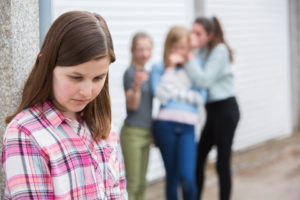Friendships and bullying are regular topics that I discuss with kids from third grade and up. It is amazing how young it starts with kids feeling left out, mistreated and like no one likes them. I hope you will learn something from this case and thank you all again for your incredibly kind words of support.
Katie was just 10 years old when she walked into my office. She was a thin girl with a messy ponytail and glasses. She just listened as her mom did most of the talking. Her mom told me all about how they had moved to a new school last year and that it was a slow start to making friends but that by the end of the year she was invited to one birthday party and things were looking up. When this school year started Katie felt like she was starting over, she was in a new class with a different mix of kids and no one to play with. She would say that she would just read during recess, sit at the end of any table during lunch and was never chosen for partner work. It was painful for her mother to share and painful for me to hear.
Although I work with many kids who have these experiences it doesn’t make me any less sensitive to it. Katie finally added some of her own stories, times when she felt purposely left out and when kids would talk about play dates and sleepovers around her. She wondered if she was doing something wrong. She wanted to know what she could do to make friends at school. Her mother wanted to know if this was bullying.
Before I go into what it was and what we did, I want to say something about sitting with someone in a room and really getting to know them. Sitting with Katie I struggled to imagine why anyone would be mean to her. She was soft spoken, kind and smart. She was so resilient, I thought about how hard it must be for her to show up to school every day not being included.
Okay, now back to the story…Katie was experiencing what we call Relational Aggression (RA). This is different from bullying in that some of the other girls, likely the more “popular” ones, were intentionally using their social status in order to diminish that of Katie’s status. Relational Aggression is more often seen in girls grades 5th and up and can have long-lasting consequences of low self-esteem, depression, and even thoughts of suicide. Come to find out after more questioning that when Katie arrived at the school as “the new kid” she quickly became the smartest kid in the class much to the dismay of some of the girls. This started the cascade of being socially outcast.
So, what did we do about it? There were 3 key steps we took in reducing and eventually stopping this from going on.
1. Got Educated- once Katie’s mom had language for what was going on (because it was not clear cut bullying) she was able to talk to the teacher about it. Once she framed up for the teacher in a clear way what was going on and that it was beyond just not making friends the teacher was able to recognize the dynamic and intervene effectively. She made some shifts in the classroom (like assigning partners instead of letting kids chose) that started to lessen the social pressures. She also communicated with all the other teachers, lunch aids and recess monitors.
2. Made 1 Ally- interestingly, in this case, it was a boy in class. Another very bright child who enjoyed playing math games in class and also started to include Katie at recess time by inviting her to play soccer. Katie and I had already spent a few sessions preparing her for making a new friend, trying things out that she may have avoided and being open. With the help of the teacher, the pairing up of this boy and Katie created a friendship. It started with just one friend but that made a world of difference. Katie was no longer as available to covertly make feel bad and she was also happier so a less desirable target. After some time, she became friends with some more of the boys and eventually with a girl from another class that was not involved with any of this. She and her new friends would play at recess and sit with each other at lunch creating some protection from the other girls.
3. United the Moms- Katie’s mom became friendlier with the moms, both of the kids who were mean to her daughter and those who were new friends. She got involved with volunteering when she could and also suggested a 5th grade service project that involved moms and daughters. This proved to be an effective strategy for joining the community and eliminating the cruelty. Other groups, guest speakers and programs were born from Katie’s mom proactively creating the change we thought needed to occur in order for Katie and all the other students to feel emotionally safe at school.
I wish I could say Katie is an exception but she is not. According to the National Center for Educational Statistics (2017) almost 1:4 children say they are bullied throughout a single school year. Adults, as much as children, need to get educated about spotting the signs of RA and bullying and what to do about it.
